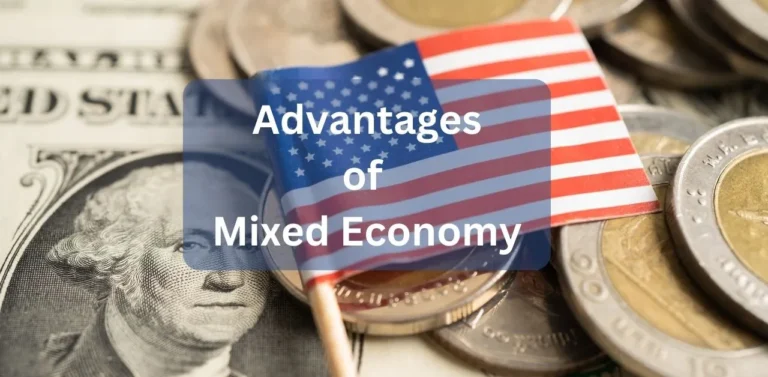In today’s world, economies come in various shapes and sizes. One popular and effective economic system is known as a mixed economy.
This approach combines elements of both market and planned economies, aiming to harness the strengths of both while mitigating their weaknesses.
The advantages of a mixed economy are:
- Economic diversity
- Social welfare programs
- Innovation and competition
- Stability and security
- Flexibility
- Balanced wealth distribution
- Infrastructure development
Let’s dive into the advantages of a mixed economy in a straightforward manner.
Advantages of Mixed Economy
At its core, a mixed economy seeks to balance individual freedom and government intervention. In this economic system, some industries are left to market forces while others are regulated or owned by the government.
This equilibrium aims to minimize the shortcomings of purely capitalist or socialist systems, creating an environment where economic growth and social well-being can coexist harmoniously.
1. Economic Diversity:
A mixed economy thrives on the principle of economic diversity. By nurturing a variety of industries, it guards against over-dependence on a single sector. This diversity not only bolsters a nation’s resilience but also enhances its global competitiveness.
Example: The United States showcases a mixed economy with a diverse range of industries, including technology, finance, agriculture, and entertainment.
2. Social Welfare Programs:
While the market emphasizes efficiency, it may not address social needs adequately. This is where a mixed economy comes to the fore.
By incorporating social welfare programs, such as affordable healthcare, education, and housing, the government ensures that essential services are accessible to all citizens.
Example: European countries like France provide universal healthcare and quality education, ensuring a higher quality of life for their citizens.
3. Innovation and Competition:
Competition ignites progress. In a mixed economy, private enterprises are motivated to engage in healthy competition. This not only fosters innovation but also encourages companies to continuously enhance their products and services to attract customers.
Example: The automobile industry has been transformed by fierce competition, with companies like Tesla leading the way in electric vehicle innovation.
4. Stability and Security:
Economic stability is the cornerstone of a prosperous nation. In times of economic upheaval, a mixed economy provides stability through government intervention. Fiscal policies, regulations, and safety nets ensure that the economy doesn’t plunge into chaos.
Example: During the Great Recession of 2008, mixed economies like Canada and Germany implemented measures to stabilize financial markets and prevent massive job losses.
5. Flexibility:
Change is a constant in the economic landscape. A mixed economy’s flexibility shines during tumultuous times.
It enables swift response to economic challenges by allowing the government to adjust policies, provide financial support, and implement regulations as needed.
Example: Amid the COVID-19 pandemic, mixed economies worldwide swiftly introduced stimulus packages to counteract economic downturns.
6. Balanced Wealth Distribution:
A mixed economy strives to curb extreme income inequality. It achieves this by implementing progressive taxation and social programs, ensuring that wealth is distributed more equitably among the population.
Example: Nordic countries like Norway and Sweden have effectively reduced income disparity through a combination of progressive taxation and social welfare policies.
7. Infrastructure Development:
Government intervention in a mixed economy often leads to significant investments in infrastructure development. This enhances a nation’s productivity and competitiveness on a global scale.
Example: China’s mixed economy has enabled it to embark on ambitious infrastructure projects like the Belt and Road Initiative, expanding its global influence.
Nations with Mixed Economy
Here’s a list of nations where a mixed economy is applied:
- United States: The U.S. employs a mixed economy with a blend of private enterprise and government intervention. Various sectors, including technology, finance, healthcare, and education, operate within this framework.
- United Kingdom: The UK’s mixed economy features a diverse range of industries, including finance, technology, manufacturing, and creative industries.
- Canada: Canada’s mixed economy emphasizes social welfare programs, offering universal healthcare and social safety nets alongside a thriving private sector.
- Germany: Germany’s mixed economy focuses on innovation and education. Government investments in education and vocational training contribute to a skilled workforce.
- Sweden: Sweden’s mixed economy is known for its robust social welfare system, offering free healthcare and education to citizens.
- France: France employs a mixed economy that includes a mix of public and private enterprises, along with social welfare programs.
- Norway: Norway’s mixed economy is characterized by its focus on reducing income inequality through progressive taxation and social welfare initiatives.
- Australia: Australia’s mixed economy balances economic diversity, innovation, and social welfare programs to create a well-rounded economic system.
- Japan: Japan’s mixed economy combines advanced technology and industry with government support and regulation to ensure stability and growth.
- South Korea: South Korea’s mixed economy has played a significant role in its transformation into a global technological and manufacturing powerhouse.
Conclusion
The advantages of a mixed economy are a testament to its adaptability and effectiveness. By blending elements of capitalism and socialism, it creates a dynamic economic environment where progress and well-being coexist.
From economic diversity and social welfare programs to fostering innovation and ensuring stability, a mixed economy offers a holistic approach to economic growth.
As nations navigate the complex terrain of economic systems, the balanced nature of a mixed economy serves as a beacon of hope, reminding us that finding the right equilibrium between market forces and government intervention can lead to a brighter and more prosperous future for all.



